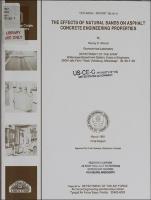Please use this identifier to cite or link to this item:
https://hdl.handle.net/11681/12821| Title: | The effects of natural sands on asphalt concrete engineering properties |
| Authors: | Air Force Engineering and Services Center (U.S.) Ahlrich, Randy C. |
| Keywords: | Aggregates Indirect tensile Asphalt concrete Natural sands Asphalt pavements Resilient modulus Gyratory testing Permanent deformation Rutting Unconfined creep Mechanical properties |
| Publisher: | Geotechnical Laboratory (U.S.) Engineer Research and Development Center (U.S.) |
| Series/Report no.: | Technical report (U.S. Army Engineer Waterways Experiment Station) ; GL-91-3. |
| Description: | Technical Report Abstract: Asphalt concrete rutting is premature deformation that develops in wheelpaths under channelized loads. Asphalt concrete mixtures that exhibit plastic flow are caused by asphalt concrete mixtures that have an excessive asphalt content and/or excessive amount of uncrushed rounded aggregate. This laboratory study was conducted to evaluate the effects of natural sands on the engineering properties of asphalt concrete. This research consisted of a literature review and a two-phase laboratory study on laboratory-produced specimens. Conventional and state-of-the-art testing procedures including indirect tensile, resilient modulus, and unconfined creep rebound were used to determine the effects of natural sands. The conclusions of the laboratory study indicated that use of natural sand materials decreased strength characteristics of asphalt concrete mixtures. Replacing natural sand materials with crushed aggregates increased the resistance to permanent deformation. This study recommends that the maximum limit for natural sand be 15 percent, but to maximize the decrease in rutting potential, all crushed aggregate should be used. |
| Rights: | Approved for public release; distribution is unlimited. |
| URI: | http://hdl.handle.net/11681/12821 |
| Appears in Collections: | Technical Report |
Files in This Item:
| File | Description | Size | Format | |
|---|---|---|---|---|
| TR-GL-91-3.pdf | 13 MB | Adobe PDF |  View/Open |